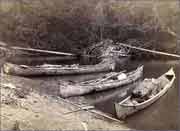Historical Vignettes
The Maliseets and the Forest: a Mutual Respect
The Maliseets of Madawaska, settled along the Saint John River Valley, lived from the products of hunting, fishing and gathering of fruits and wild plants. They seemed little inclined to adopt agriculture as a way to survive and used natural resources to develop a good number of useful tools. Canoes, houses, moccasins, snowshoes, baskets and containers of all kinds were built from certain types of wood and leather.
The Indians designed and developed the necessities of life without metal tools, cannon powder, woven fabric, glass or manufactured pieces of wood. Instead, they used stone, clay and practically every part of the plant and the animal: roots, bark and wood, skin, bones, ivory, antlers, shells, hair, fur, feathers, quills, and tendons. (...) By observing what people make by hand, we can learn much about their lifestyle. Think about the canoe. As a solution to the problem of transportation in the Maritimes, it was ideal, so ideal in fact, that it continues to be used today.6
In 1860, the “Maliseet village” of Saint-Basile becomes an official Indian Reservation. Hunting and fishing territories go from 9000 square miles to 722 acres. Later, with the construction of the Trans-Canada Highway, high-tension wires, railways and the Fraser pipeline, there would only remain 600 acres. The Madawaska Maliseet First Nation would have to adapt to these new realities, not without difficulties.7

